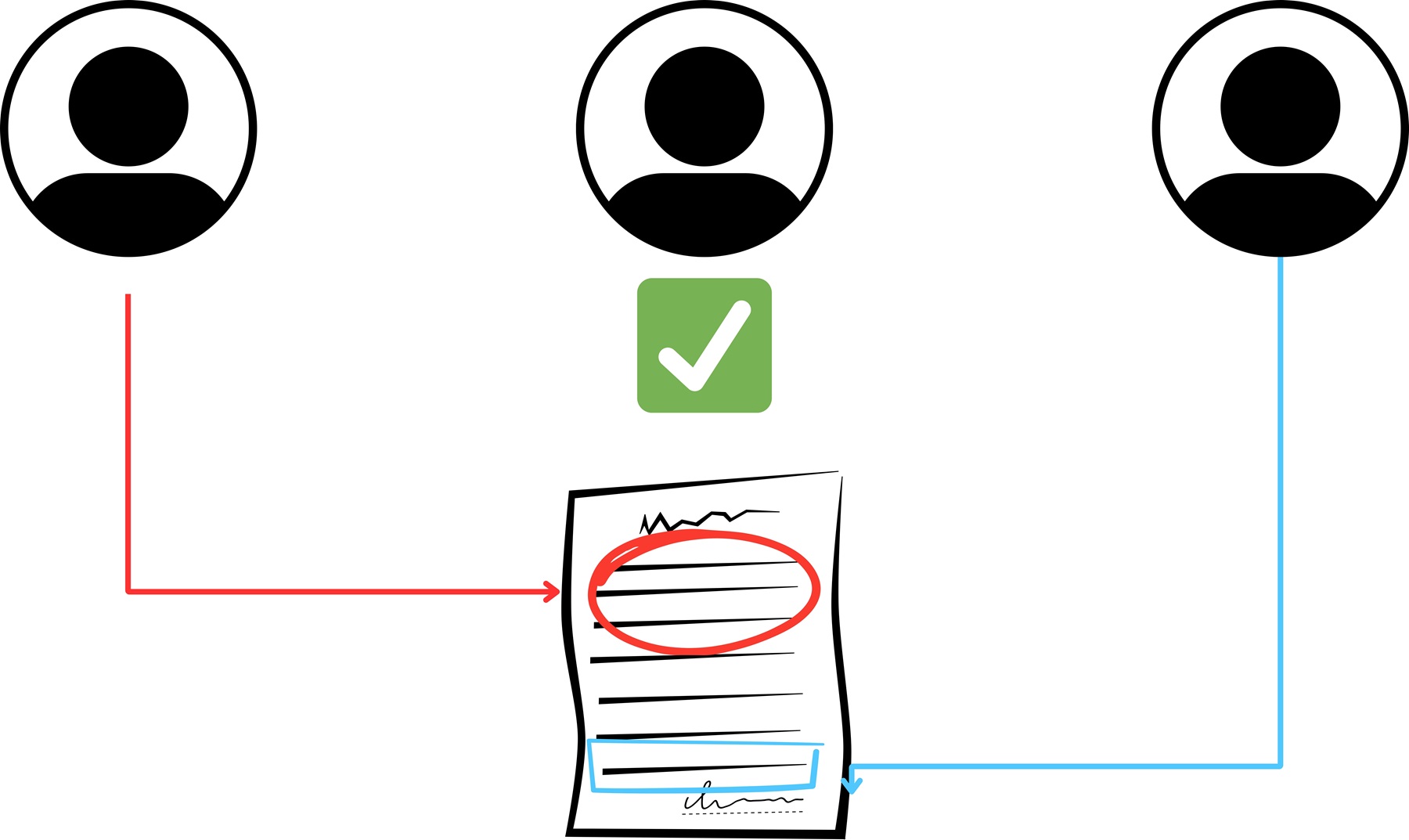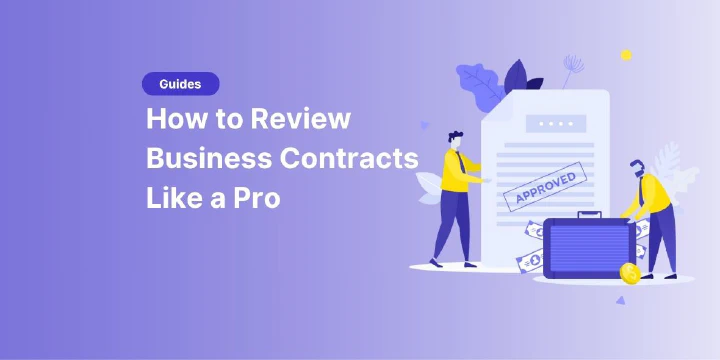What is Contract Redlining?
Contract negotiations can be incredibly complex. Many contracts are sent back and forth between different parties several times before they are finalized. This back and forth is called “redlining” and is critical to developing agreements that satisfy everyone. This process is very important, especially to reduce legal risks in negotiations as much as possible.
- What does redlining a contract mean?
- How does “redlining” work specifically?
- When should you use redlining?
- Best Practices in Redlining
- The challenges of contract redlining
- Manage contract redlining effectively
- Uncompromising product features that help.
- Contract redlining made easy with fynk
- Frequently Asked Questions

What does redlining a contract mean?
Redlining is the process of editing a contract where two or more parties are negotiating or collaborating. The goal is to produce a joint document that satisfies all parties.
The term redlining comes from the original, physical method of editing a contract, which involved printed paper and red pen. One party would take the document and cross out words and add changes in red ink. That document would then go to the next processor, who would do the same. The red ink made it easy for everyone to see the exact changes that were made. Eventually, everyone would agree on a version of the contract. A clean document was then created at the end to fix the final agreement.
Today, the process is much simpler. With fynk’s contract management software, you can redline contracts in real time, edit them together. Your legal department doesn’t have to worry about sending physical copies back and forth to manage the different versions. This can help you speed up your contract negotiation process by days or even weeks.
Historical Background of Contract Redlining
In the early days of contract negotiations, redlining was a manual and time-consuming process. Originating from the practice of using red ink to highlight changes on physical documents, it played a crucial role in clarifying and negotiating terms between parties.

This method, although effective in its time, was fraught with the challenges of maintaining document integrity across multiple versions and ensuring that all parties had access to the latest revisions. As business dealings became more complex and globalized, the need for a more efficient method became apparent.
Finally, the advent of digital technologies revolutionized this process. The transition from paper to digital formats marked a significant turning point, vastly improving the speed, accuracy, and convenience of contract negotiations.
This evolution reflects not just a change in tools but also a shift in how businesses approach collaboration and legal compliance, ensuring that modern contract redlining is both efficient and adaptable to the fast-paced nature of today’s business world.
Technological Advancements in Contract Redlining
T echnological advancements have transformed the landscape of contract redlining dramatically. Modern digital solutions, such as AI and machine learning, have introduced unprecedented efficiency and precision in the redlining process.
These technologies enable sophisticated tracking of changes, automate repetitive tasks, and even predict potential contractual issues based on learned patterns. AI algorithms can suggest language improvements, identify clauses that commonly cause disputes, and ensure consistency across various documents.

Collaboration has also been enhanced through cloud-based platforms, allowing real-time updates and edits from multiple parties regardless of their geographical locations. This shift to digital tools not only accelerates the negotiation process but also minimizes human error, ensuring a higher level of accuracy in the final contract.
By leveraging these technological advancements, organizations can streamline their contract management processes, foster better collaboration, and make more informed decisions, ultimately leading to more robust and reliable contractual agreements.
How does “redlining” work specifically?
Redlining is more than just editing. It’s a collaborative process where all parties involved in the contract work together to create a document that satisfies everyone. In the past, this was done with paper documents and red pens, but today it is mostly done via computer files.
Specifically, Party A submits a contract to Party B. Party B makes changes. This new version is passed to Party A, which makes its own changes and approves or rejects Party B’s changes before sending the file back.
This continues until all parties are satisfied with the contract.
Legal Implications of Redlining
The legal implications of contract redlining are profound and multifaceted. At its core, redlining serves as a critical process in ensuring that all contractual changes are mutually agreed upon, legally binding, and compliant with applicable laws and regulations.
Proper documentation and tracking of these changes are vital, especially in scenarios where contracts may be subject to scrutiny or disputes. Inaccurately documented or poorly managed redlining can lead to legal challenges, with parties contesting the validity of contract terms or claiming misrepresentation.
Furthermore, in industries subject to stringent regulatory compliance, precise redlining is indispensable for demonstrating adherence to legal standards. This underscores the importance of a meticulous and transparent approach to redlining, ensuring that all modifications are clearly indicated, agreed upon by all parties, and in line with legal and regulatory requirements.
Thus, redlining is not just a tool for negotiation; it is a safeguard against legal risks and a means to uphold the integrity of contractual agreements.
When should you use redlining?
You must use redlining on a contract whenever more than one person needs to agree on the final version. It is most commonly used when multiple groups are negotiating the terms of a new contract, but that is not the only used case where it is used. You may also need to use redlining with contracts where you are creating a new contract template or revising old contracts.
Any time you need to refine a contract with others, redlining can be a valuable strategy. Especially if you rely on digital contract management for this process.
Best Practices in Redlining
Effective redlining is pivotal in achieving clear, accurate, and mutually agreeable contracts. To optimize this process, several best practices should be adhered to.
Open communication
Firstly, maintaining open and transparent communication is essential. All parties should be encouraged to express their concerns and clarifications throughout the redlining process.
Document Integrity
Secondly, it’s crucial to ensure document integrity. This involves keeping a clear record of all changes made, who made them, and when. Tools, such as fynk, offer version control and change tracking are invaluable in this regard.
Collaboration, Timelines & Expectations
Thirdly, a collaborative approach should be adopted. Redlining should be seen as a cooperative effort rather than a confrontational one, with the goal of reaching a consensus that benefits all parties. Additionally, setting clear timelines and expectations can help keep the process efficient and prevent unnecessary delays.
Standardized Language
Finally, considering the use of standardized language for common contract clauses can reduce the need for extensive redlining, making the process more straightforward. Adhering to these best practices ensures a smoother, more efficient redlining process, ultimately leading to better contract outcomes.
The challenges of contract redlining
Redlining is helpful, but it can still have its challenges. With the wrong contract management tool, redlining quickly leads to a mess instead of a cohesive agreement. Some problems you may encounter with redlining are:
Confusing changes: If you edit your agreements using a traditional word processor, it can quickly become difficult to spot differences and read the resulting text. If one party forgets to track their changes, errors can result.
Incorrect formats: If too many people make changes to a document over time, you may find that the formatting is incorrect. This forces you to spend extra time getting it back to your preferred look.
Incompatible file types: There are so many different versions of Microsoft Word that you can quickly run into incompatible file types when you try to edit documents with others. This can damage or even completely destroy the formatting of your contract.
Slow response time: depending on how you send your drafts, you may not receive the revised document back for days or weeks. This significantly slows down the contracting process.
These problems are critical, but they can be solved with the right contract management system.
Manage contract redlining effectively
Depending on your organization, contract redlining can involve dozens of revisions. Your legal department must track each of these changes and work with customers and vendors to arrive at a satisfactory agreement. Providing the right tools can help streamline contract workflow and significantly reduce the time spent redlining.
The easiest way to redline a document is for both parties to work on it together. While this is not always possible in person, it can be easily accomplished through digital contracting. By using cloud-based contract management software, all parties can view the contract at any time to edit it or approve or reject changes. The document is stored in a central location, avoiding the problems of incompatible file formats.

With cloud-based contract management software, you can also track document changes cleanly. The tool automatically tracks changes until the document is approved, giving you a clear view of what changes were made, by whom, and when.
Uncompromising product features that help.
If you’re looking to improve your redlining workflows, fynk can help. The cloud-based solution implements the entire agreement editing process in the browser.
For agreements you send frequently, fynk lets you create workflow templates. With these templates, you can define your agreements with options up front, rather than having to deal with significant redlining revisions later. You can use our workflow designer to offer clauses that have been pre-approved by your legal department, so your sales team doesn’t have to contact legal for every customer request.
You can also implement the clickwrap feature if you use standardized agreements. This immensely reduces the number of contracts you need to handle and speeds up the contract process.
Contract redlining made easy with fynk
Contract redlining is an essential part of any contract negotiation. That’s why it’s important to set up an effective system to manage the redlining process. You can simplify the editing process, avoid costly mistakes, and reduce wasted time.
fynk’s digital contract management software helps simplify redlining. With fynk’s editor and workflow designer, your legal team can streamline the redlining process. You can provide a better experience for your customers and suppliers while giving your team time to focus on more important things.
Searching for a contract management solution?
Find out how fynk can help you close deals faster and simplify your eSigning process – request a demo to see it in action.
Frequently Asked Questions
- What exactly is contract redlining?
- Contract redlining is the process of editing and negotiating a contract by marking changes, comments, and suggestions directly on the document. It's a collaborative effort between parties to reach a mutually agreeable final version.
- Why is redlining important in contract negotiations?
- Redlining is crucial because it ensures clarity, transparency, and mutual understanding in contract terms. It helps all parties to track changes, negotiate terms, and avoid misunderstandings or legal issues later.
- How has redlining evolved from its traditional methods?
- Traditional redlining involved marking physical documents with red ink. It has evolved into digital redlining using software tools (like fynk) that allow real-time collaboration, change tracking, and version control.
- What are the legal implications of redlining?
- Redlining has significant legal implications as it ensures that all contract modifications are agreed upon and documented. This is crucial for contract enforceability and can be critical in resolving legal disputes.
- How do technological advancements impact redlining?
- Technological advancements, like AI and cloud-based platforms such as fynk, have streamlined the redlining process. They facilitate real-time collaboration, automatic change tracking, and improved accuracy.
- What are the best practices for effective contract redlining?
- Best practices include maintaining open communication, ensuring document integrity, using version control, setting clear timelines, and adopting a collaborative approach.
- What challenges are commonly faced in redlining and how can they be resolved?
- Common challenges include managing confusing changes, maintaining formatting, handling incompatible file types, and slow response times. These can be resolved using advanced contract management tools and clear process guidelines.
- What tools are recommended for contract redlining?
- Tools like fynk's cloud-based contract management software, which offer features like version control, real-time collaboration, and change tracking, are highly recommended.
- Is redlining necessary for all types of contracts?
- While not all contracts may require extensive redlining, it is recommended for any contract where multiple parties must agree on terms, especially in complex or high-stake agreements.
- How can one ensure the security and confidentiality of contracts during the redlining process?
- Using secure contract management platforms with encryption, access controls, and data protection features is crucial for maintaining confidentiality and security.
- Can redlining be used for negotiating contracts across different jurisdictions?
- Yes, redlining is effective for cross-jurisdictional contracts, but it's important to consider the legal requirements and cultural nuances of all involved jurisdictions.
- How do different parties collaborate effectively in a redlining process?
- Effective collaboration involves clear communication, respect for each party's perspective, timely responses, and the use of collaborative tools that support multiple users.
- What role do lawyers play in the redlining process?
- Lawyers play a key role in ensuring that the contract terms are legally sound, compliant with relevant laws, and that the interests of their clients are well-represented.
- How long does the redlining process typically take?
- The duration of the redlining process varies based on the complexity of the contract, the number of parties involved, and the efficiency of the negotiation process.
- Can redlining lead to significant changes in a contract?
- Yes, redlining can lead to significant changes as it involves negotiation and revision of terms. The extent of changes depends on the negotiations and the initial draft's alignment with all parties' interests.
Please keep in mind that none of the content on our blog should be considered legal advice. We understand the complexities and nuances of legal matters, and as much as we strive to ensure our information is accurate and useful, it cannot replace the personalized advice of a qualified legal professional.

Table of contents
- What does redlining a contract mean?
- How does “redlining” work specifically?
- When should you use redlining?
- Best Practices in Redlining
- The challenges of contract redlining
- Manage contract redlining effectively
- Uncompromising product features that help.
- Contract redlining made easy with fynk
- Frequently Asked Questions
Want product news and updates? Sign up for our newsletter.
Other posts in Contract-Management

How to Review Business Contracts Like a Pro in 2025
When it comes to business contracts, what you don’t catch can hurt you. That’s why reviewing a business …

10 Best Contract Lifecycle Management Practices in 2025
Remember when closing a deal meant printing five copies, couriering them for “wet” signatures, then hunting …

How to Write a Contract Proposal (+Examples)
Imagine a freelance marketing consultant gearing up to pitch their services to a mid-sized tech company. …
Contracts can be enjoyable. Get started with fynk today.
Companies using fynk's contract management software get work done faster than ever before. Ready to give valuable time back to your team?
Schedule demo

